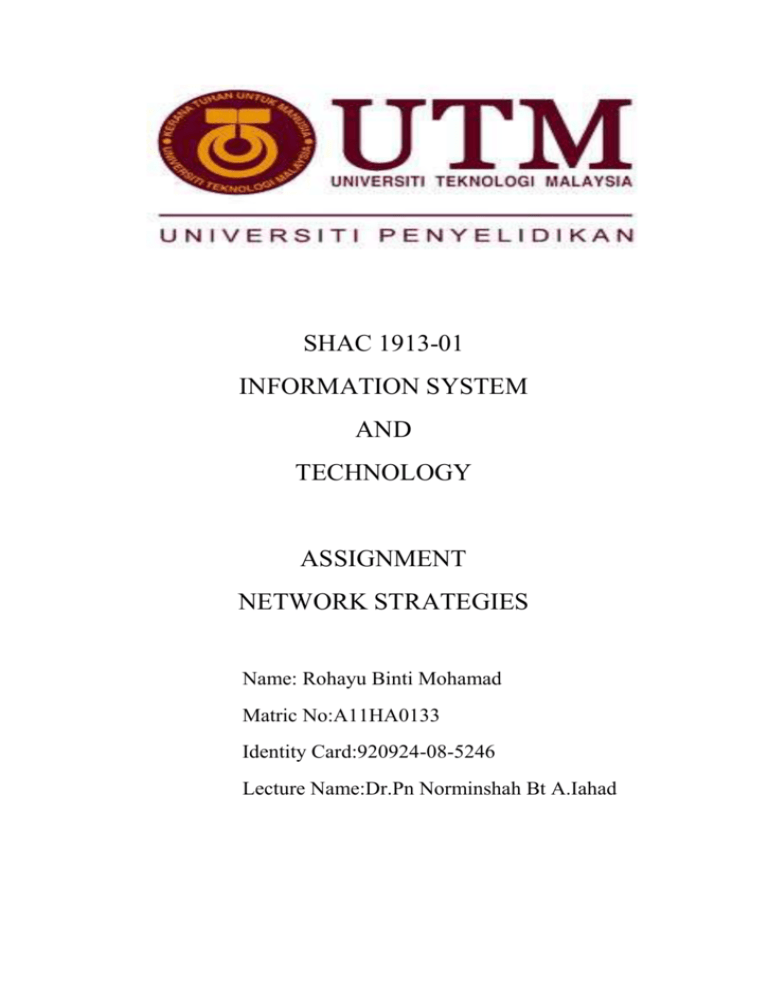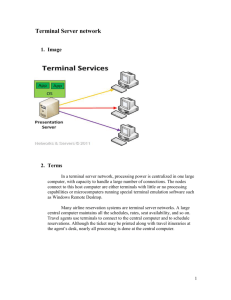client server network
advertisement

SHAC 1913-01 INFORMATION SYSTEM AND TECHNOLOGY ASSIGNMENT NETWORK STRATEGIES Name: Rohayu Binti Mohamad Matric No:A11HA0133 Identity Card:920924-08-5246 Lecture Name:Dr.Pn Norminshah Bt A.Iahad Table Of Content Content Page Terminal Server Network 1-3 Client Server Network 4-6 Peer To Peer Network 6-10 Distributing Processing Network 11-13 Reference 14 TERMINAL SERVER NETWORK Definition -A terminal server (also referred to as a serial server or network access server) enables organizations to connect devices with an RS-232, RS 422, or RS 485 serial interface to a local area network (LAN). There are also many terminal servers on the market that have highly advanced security functionality to ensure that only qualified personnel can access various servers and that any data that is transmitted across the LAN, or over the Internet, is encrypted. Advantages of Terminal Server Network - Enhances Productivity Throughout the Organisation • Centralised application hosting. Effectively deliver applications across the enterprise to meet different needs, without straining network resources or exposing corporate data to unnecessary risks. • Cost-effective application management. Reduce the costs and challenges of maintaining desktop machines with applications that are frequently updated, infrequently used, or hard to install - or that need to be accessed over low-bandwidth connections. • Efficient application deployment. Use a local- or wide-area network to deliver high-performance computing resources to remote and mobile employees. Provide core Windows applications to users of legacy PCs or thin client devices. Enables Efficient, Cost-Effective Application Management • Remote Troubleshooting. Give help desk staff the ability to view or control Terminal Services sessions, such as those in branch offices, providing faster customer service. IT administrators can remotely manage any computer running Windows Server and leverage the tight integration of Terminal Services with other features such as Active Directory services, Group Policy, Windows Management Instrumentation and the Microsoft Management Console. • Feature-rich terminal experience. Deliver high-performance computing capabilities to remote workstations with lower bandwidth. Enable clients running Terminal Services to connect to a pool of servers running Windows Terminal Server to help balance network loads and eliminate failure points. And use Client Connection Manager to enable administrators or end users to set up predefined connections to one or several servers for single-application or full-desktop access. Disadvantages of Terminal Server Network The terminal server needs to be powerful enough to be able to handle all connections. The network needs to be sized appropriately so that it is not the bottleneck when terminal server sessions are established. The terminal server is the major source of risk of downtime. If the terminal server fails, the whole system fails unless a fail-over terminal server is in place. The functionality of the system as a whole is also affected by the network reliability. If the network is down, the whole system is down as well. Running applications from a terminal server can also be an issue from performance perspective. In some cases, no matter how good the network is, the performance associated with running an application locally on a desktop workstation can still overshadow the benefits of a terminal server environment. Another disadvantage can be the availability of skilled administrator. Support for a terminal server needs to have the necessary knowledge and be available as the business needs commands. CLIENT SERVER NETWORK Definition The client–server model is a computing model that acts as a distributed application which partitions tasks or workloads between the providers of a resource or service, called servers, and service requesters, called clients. Often clients and servers communicate over a computer network on separate hardware, but both client and server may reside in the same system. Advantages Of Client-server Network Simplicity -With a client-server architecture, the user experience is an extremely simple and straight forward one. Users can log on to any computer on the network when they do so, they see the same drive mappings and the same files every time. Easy Of Backup -With a client-server configuration, you can easily centralize the backups. Each night, a backup takes place on the server capturing all changes made during the day. If a user overwrites or deletes a file, the system administrator can simply go to the most recent and restore that file. Lower Cost -The client-server architecture can provide lower costs for the company than individual computers each running their own programs. System administration can purchase a single server, load it with the programs they need and then use inexpensive computers or terminals to connect to those central resources. Security Many times, servers have higher security than clients. Servers also can control and protect data information by allowing only clients with the proper permission to access the resource. Control The client-server architecture gives the IT staff much more control, allowing them tocontrol everything from software licenses to file access. Once the architecture is in place,individual users and groups of users can receive access to only the files they need to do their jobs, making the network more secure and reducing the chances that files will be moved or damaged, either inadvertently or intentionally. The client-server system also makes it easy to distribute updates to the operating system as well as updates to the antivirus and anti-spyware software products. Disadvantages Of Client-Server Network Single Point of Failure One of the major disadvantages of client server computing is the possibility for a single point of failure. For example, if a network's central server fails, users may not be able to access data or resources they need from their clients. Such failures can have large and costly implications for businesses. Peer-to-peer networks are not vulnerable to this because if a single client fails, the responsibilities get evenly distributed throughout the remaining clients on the network. Overload Extremely busy networks can sometimes overload and crash a server. Servers are only capable of executing a certain amount of commands per second, so extreme network congestion can cause the server to overload and crash, making files and resources unavailable to users. Even the most powerful and expensive servers have a limit. In contrast, peer-to-peer networks continue to operate, though not at full capacity, if a single client becomes overloaded by requests and crashes. Cost The costs of setting up a client-server computing environment can be extremely prohibitive. Servers typically cost $5000 or more and the complexity of the network design and administration can also be very expensive. Companies that install a client-server computing system must invest in the necessary equipment including servers, clients and networking cables, hire IT professionals to design and set up the server and network, as well as pay for on going maintenance issues and technology upgrades for the life of the network. With peer-topeer, single computers can be upgraded to improve the network's efficiency over time, and personal computers are considerably less expensive than server . . PEER TO PEER NETWORK Definition Peers make a portion of their resources, such as processing power, disk storage or network bandwidth, directly available to other network participants, without the need for central coordination by servers or stable hosts. Peers are both suppliers and consumers of resources, in contrast to the traditional client–server model where only servers supply (send), and clients consume (receive). The peer-to-peer application structure was popularized by file sharing systems like Napster. The concept has inspired new structures and philosophies in many areas of human interaction. Peer-to-peer networking is not restricted to technology, but covers also social processes with a peer-to-peer dynamic. In such context, social peer-to-peer processes are currently emerging throughout society. Advantages of Peer to Peer Network In P2P networks, clients provide resources, which may include bandwidth, storage space, and computing power. This property is one of the major advantages of using P2P networks because it makes the setup and running costs very small for the original content distributor. As nodes arrive and demand on the system increases, the total capacity of the system also increases, and the likelihood of failure decreases. If one peer on the network fails to function properly, the whole network is not compromised or damaged. It enables different types of information to be shared more easily and this is if the user wants to download some information to the computer or uploading the information from the computer. A large amount of file sharing can be handled by the peer to peer network and this is, because the load is balanced through several computers, as a central server is not required. The other advantages for a peer to peer network are for example it is inexpensive, simple to use and manage. The reason for this is that the only costs that are included are for the hardware itself, such as the maintainence and even the cabling. The advantage of peer-to-peer networks over information networks of other types shows up in their substantial and growing popularity. Because they need no central computer server to mediate the exchange of information or files among users, the high-bandwidth communications capacity for a server may be dispensed with, and the need for costly server storage space is eliminated. Since copies of a file (particularly a popular one) are available on many users’ computers, file requests and retrievals may be faster than on other types of networks, and since file exchanges do not travel through a server, communications can take place between any computers that remain connected to the network without risk that a glitch in the server will disable the network in its entirety. Disadvantages of Peer to Peer Network There are also many disadvantages of a peer to peer network for example the minimal of security this means that there is not much security on the systems as anyone can have access to the shared files. Therefore if the users want to reduce the risk of unauthorised users going access to the personal information then they need to setup a password themselves, but this could be difficult as some users don’s secure their resources with a password. Peer-to-peer networks have disadvantages as well. Searches on peer-to-peer networks may not reach and uncover all available files because search requests may not be transmitted to every computer on the network. There may be redundant copies of popular files. The creator of the software has no incentive to minimize storage or bandwidth consumption, the costs of which are borne by every user of the network. Most relevant here, it is more difficult to control the content of files available for retrieval and the behaviour of users, Another disadvantage to end users can be that viruses are available on the majority of peer to peer programs and usually the virus is masked as a music or video file this in turn can severely damage computers and in some cases can make the computer in operable. According to (Clark, 1995) There are usually 3 different types of computer viruses. There are what is known as boot viruses which affect the master boot record (mbr), file allocation table (fat), and partition table. Program viruses which affect file extensions like: .com, .exe, .ovl, .drv, .sys, and .bin. The third computer virus is what is known as the Multipartite virus which affects both the program and boot sectors. File sharing and peer to peer is largely viewed as taboo by most people involved within the entertainment industry due to the fact that holders of copyright aren't being paid for the use of there materials. For example recording artists usually gain what is known as an record advance by there respected record company which is really a recoupable loan in which the recording artist is liable for. Out of this advance the recording artist is meant to pay for there management fees and recording sessions and marketing fees. When the recording artists goes onto release there album or single the average recording artist earns 20 - 25p per cd sold and the rest goes back to the record company. The recording artist has to pay back the recording advance out of the money that they earn so from the recording artists view if there album or single is available on the internet and people are sharing there album people usually wont go out to buy there album and this in turn costs them and the recording company money. And in some cases can lead to the recording artists being dropped by there record company DISTRIBUTING PROCESSING Definition Distributed processing is a phrase used to refer to a variety of computer systems that use more than one computer (or processor) to run an application. This includes parallel processing in which a single computer uses more than one CPU to execute programs. More often, however, distributed processing refers to local-area networks (LANs) designed so that a single program can run simultaneously at various sites. Most distributed processing systems contain sophisticated software that detects idle CPUs on the network and parcels out programs to utilize them. Advantages of Distributing Processing Network • Quicker response time: By locating processing power close to user, response time is typically improved. This means that the system responds rapidly to commands entered by users. • Lower costs: Long-distance communication costs are declining at a slower rate than the cost of computer power. Distributed processing can reduce the volume of data that must be transmitted over long-distances and thereby reduce long-distance costs. • Improved data integrity: High degrees of accuracy and correctness may be achieved by giving users control over data entry and storage. • Reduced host processor costs: The productive life of a costly mainframe can be extended by off-loading some its processing tasks to other, less expensive machines (whose total costs usually a fraction of the cost needed to up-grade the central processor). • Resource sharing: One of the main advantages of developing microcomputer networks is because they make it possible to share expensive resources such as highspeed, colour laser printers, fast data storage devices, and high-priced software packages. Disadvantages of Distributing Processing Network Managing and controlling is complex, there is less security because data is at so many different sites. Distributed databases provides more flexible accesses that increase the chance of security violations since the database can be accessed throughout every site within the network. The ability to ensure the integrity of the database in the presence of unpredictable failures of both hardware and software components is also an important features of any distributed database management systems. The integrity of a database is concerned with its consistency, correctness, validity, and accuracy. The integrity controls must be built into the structure of software, databases, and involved personnel. If there are multiple copies of the same data, then this duplicated data introduces additional complexity in ensuring that all copies are updated for each update. The notion of concurrency control and recoverability consume much of the research efforts in the area of distributed database theory. Increasing in reliability and performance is the goal and not the status quo. Reference Read more: Client Server Advantages & Disadvantages | eHow.com http://www.ehow.com/facts_5525462_client-server-advantagesdisadvantages.html#ixzz1g6i1lVDC Read more: Advantages of a Client-Server Computer | eHow.com http://www.ehow.com/info_8533810_advantages-clientservercomputer.html#ixzz1g6iKXtMu Read more: The Disadvantages of Client Server Computing | eHow.com http://www.ehow.com/list_7212383_disadvantages-client-servercomputing.html#ixzz1g6iaH1Rz http://iictblog.wordpress.com/2011/12/02/m1-compare-the-benefits-and-disadvantages-ofpeer-to-peer-network-and-client-server-networks/ http://www.ehow.com/search.html?s=terminal+server+network&skin=corporate&t=all http://www.ehow.com/search.html?s=distributing+processing+network&skin=corporate&t=a ll







